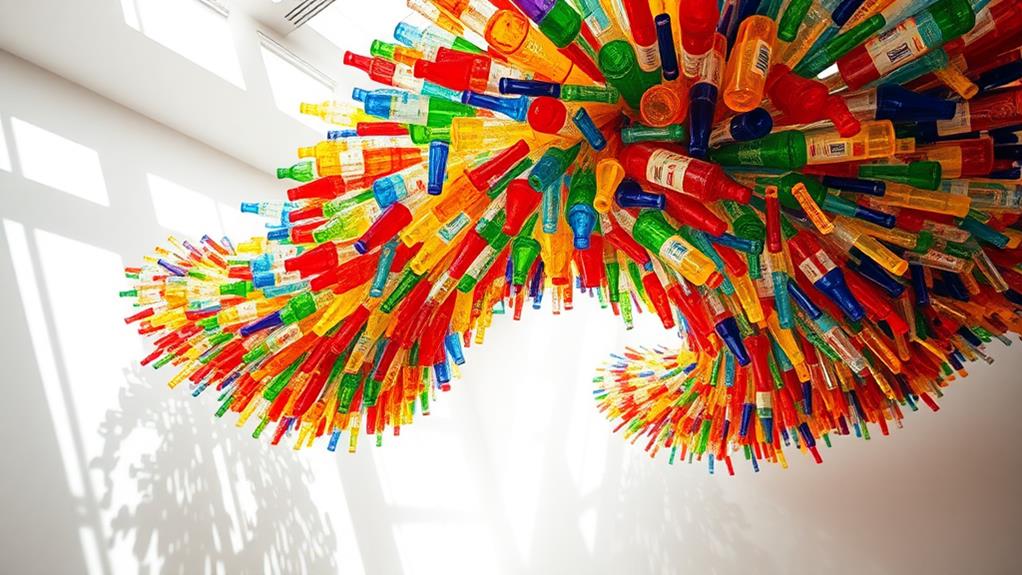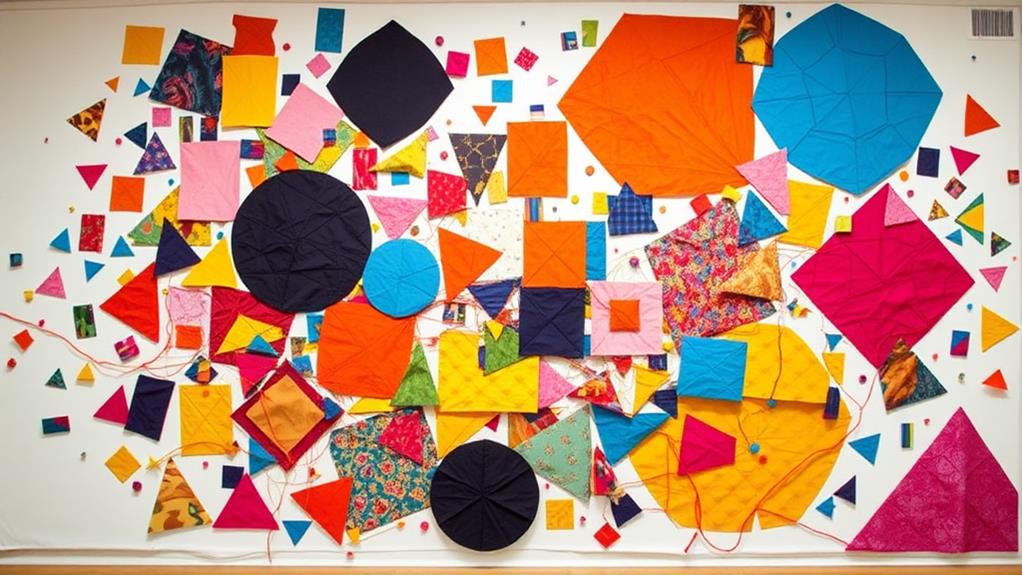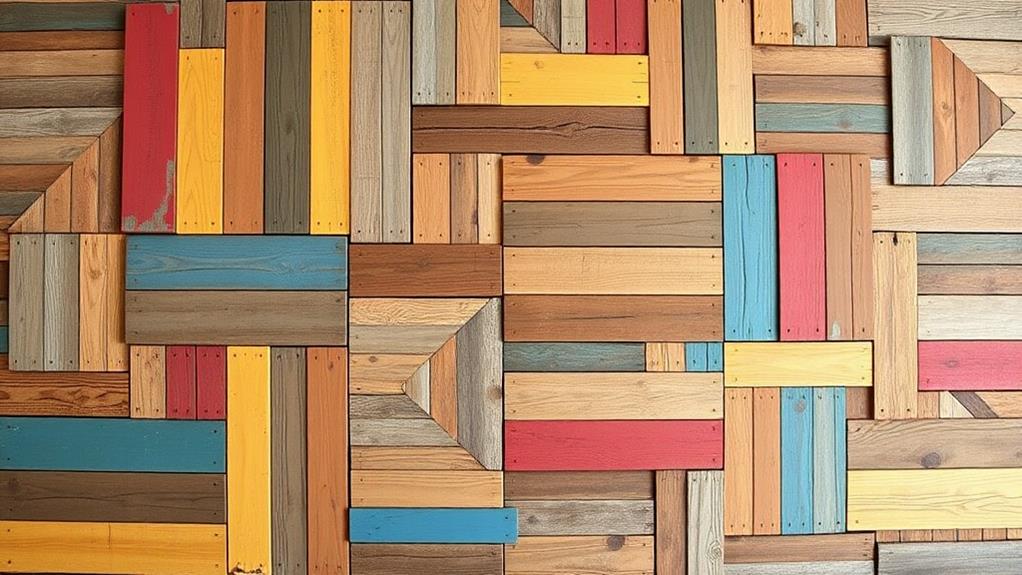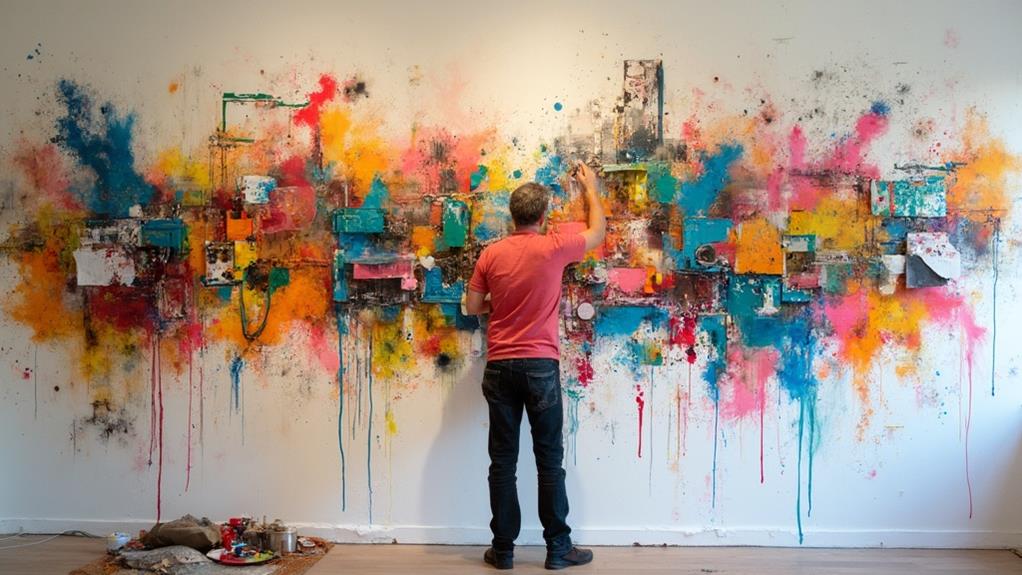Creating large-scale DIY art projects on a budget is an excellent way to personalize your space. Options range from oversized abstract paintings to wall tapestries, geometric designs, and repurposed object installations. Large-scale photo prints offer visual impact, while textile-based art adds texture. Paper sculptures and upcycled wood pieces provide three-dimensional interest. Mixed media collages allow for creative combinations of materials. These projects often require minimal investment in supplies, utilizing items you may already have or can source inexpensively. With some creativity and effort, you can transform your walls into stunning focal points. Discover how these budget-friendly techniques can help you create impressive, gallery-worthy art.
Oversized Abstract Paintings

Abstract expressionism comes to life on a grand scale with oversized abstract paintings. These striking pieces can transform a room, creating a focal point that captivates viewers and sparks conversation. To create your own oversized abstract masterpiece, start with a large canvas or repurpose a wooden board. Prime the surface and select a color palette that complements your space.
Begin by applying broad strokes of paint using oversized brushes, rollers, or even your hands. Experiment with various techniques such as dripping, splattering, or layering to build depth and texture. Don't be afraid to mix media; incorporate elements like sand, tissue paper, or metallic leaf for added dimension.
As you work, step back frequently to assess the overall composition. Remember that abstract art is about expressing emotion and energy rather than depicting recognizable forms. Allow the piece to evolve organically, embracing happy accidents and unexpected outcomes. Once satisfied, seal your artwork with a clear varnish to protect it from dust and UV damage. Hang your oversized abstract painting in a prominent location to maximize its impact and enjoy your unique, budget-friendly creation.
Large-Scale Photo Prints
Countless ordinary photographs can be transformed into stunning works of art through large-scale photo prints. This DIY technique allows you to create impactful, gallery-worthy pieces without breaking the bank.
To begin, select a high-resolution image with strong visual appeal and minimal noise. Consider landscape shots, architectural details, or abstract close-ups for maximum impact.
Next, determine the desired size for your print, keeping in mind the available wall space and the image's resolution. Many online printing services offer affordable large-format options, including canvas, metal, or acrylic prints. Alternatively, for a more budget-friendly approach, use a local print shop to create oversized paper prints, which can be mounted on foam board or framed.
To enhance the visual impact, experiment with triptychs or grid layouts using multiple prints of the same image or related shots. For a unique twist, try splitting a single image across several panels.
When displaying your large-scale photo prints, consider factors such as lighting, viewing distance, and surrounding decor to create a cohesive and striking visual statement in your space.
Wall Tapestries and Hangings

While large-scale photo prints offer a modern aesthetic, wall tapestries and hangings provide a softer, more textural approach to DIY wall art. These versatile pieces can be created using various materials and techniques, allowing for endless customization options.
Macramé, a popular knotting technique, can be used to craft intricate wall hangings using cotton rope or yarn. For a more rustic look, consider weaving a tapestry using natural fibers like wool or jute on a simple frame loom.
Fabric-based tapestries offer another avenue for creativity. Repurpose vintage textiles, such as scarves or tablecloths, by mounting them on wooden dowels or frames. Alternatively, create your own designs using fabric paint, embroidery, or appliqué techniques on plain fabric. For a unique twist, experiment with unconventional materials like paper, plastic, or even recycled items to construct eye-catching wall art.
When hanging your creation, consider using decorative rods, branches, or driftwood for added visual interest. Wall tapestries and hangings not only serve as striking focal points but also help absorb sound and add warmth to any room.
Geometric Wall Art
Precision and symmetry define geometric wall art, making it a popular choice for those seeking a modern and visually striking aesthetic. This style of art emphasizes clean lines, shapes, and patterns, often incorporating bold colors or monochromatic schemes to create visually captivating pieces.
To create geometric wall art on a budget, start with a large canvas or wooden panel as your base. Use painter's tape to outline your desired shapes and patterns, ensuring straight edges and crisp corners. Acrylic paints are an affordable and versatile option for filling in the shapes, allowing for easy layering and blending of colors.
For a more three-dimensional effect, consider using wood strips or dowels to create raised geometric patterns. Paint them in contrasting colors or leave them natural for a rustic touch. Alternatively, cut geometric shapes from colored cardstock or thin wood and arrange them in a pleasing composition on a neutral background.
Incorporate metallic elements using gold leaf or metallic spray paint to add depth and visual interest. Remember to maintain balance in your design, whether through symmetry or intentional asymmetry, to achieve a polished and professional look.
Repurposed Object Installations

Repurposed object installations offer a creative departure from the structured precision of geometric wall art, embracing a more eclectic and eco-friendly approach to home decor. This art form involves transforming discarded items into visually striking compositions, giving new life to objects that might otherwise end up in landfills.
To create a repurposed object installation, start by collecting various items with interesting shapes, textures, or colors. These could include old books, vintage kitchenware, discarded machinery parts, or even broken furniture pieces. Arrange these objects in a visually appealing manner, considering balance, contrast, and flow. You may choose to group similar items together or create a more random, eclectic mix.
Consider using a unifying element, such as painting all objects a single color or arranging them in a specific shape, to create cohesion. Secure the objects to a sturdy backing board or directly to the wall using strong adhesives or mounting hardware. Remember to consider the overall weight and distribution of the installation to ensure it remains safely affixed to the wall.
DIY Murals
DIY murals stand out as a bold and expressive form of home decoration, allowing individuals to transform entire walls into stunning works of art. These large-scale paintings can dramatically alter the ambiance of a room, creating a focal point that captures attention and sparks conversation. With careful planning and execution, even those with limited artistic experience can create impressive murals on a budget.
To begin, select a design that complements your space and skill level. Simple geometric patterns or abstract designs are often more forgiving for beginners. Prepare the wall surface by cleaning, sanding, and priming it to ensure paint adhesion. Use painter's tape to outline your design and create clean edges. Choose high-quality, durable paints suitable for interior walls, and consider using a projector to trace complex designs onto the wall.
Work in sections, starting from the top and moving downward to avoid smudging. Allow each layer to dry completely before adding details or additional colors. For added depth and interest, experiment with different painting techniques such as sponging, stenciling, or color gradients. Finally, seal your mural with a clear protective coat to ensure longevity and easy maintenance.
Fabric and Textile Art

Weaving together creativity and tactile expression, fabric and textile art offers a diverse range of DIY possibilities for enthusiasts of all skill levels. This versatile medium allows artists to create large-scale pieces using affordable materials and simple techniques. From wall hangings to quilts, the options are limitless.
One popular approach is macramé, which involves knotting cords to create intricate patterns. Large-scale macramé wall hangings can transform a space with minimal investment. Another technique is fabric collage, where various textiles are layered and stitched together to form a cohesive piece. This method is ideal for repurposing old clothing or fabric scraps.
For those interested in dyeing, shibori is an ancient Japanese technique that produces stunning patterns on fabric. Large pieces of cloth can be folded, tied, and dyed to create eye-catching wall art or room dividers. Alternatively, patchwork quilting allows artists to combine small fabric pieces into expansive, colorful designs that serve both decorative and functional purposes.
Embroidery and needlework can also be scaled up for dramatic effect, using oversized hoops or frames to showcase intricate stitchwork on a grand scale.
Sculptural Paper Creations
Paper, a ubiquitous material, transforms into a powerful medium for three-dimensional art when employed in sculptural creations. Its versatility allows artists to craft intricate designs, from delicate origami to large-scale installations. Paper sculptures can range from abstract forms to realistic representations, limited only by the artist's imagination and skill.
To begin, select appropriate paper types based on the desired effect. Thick cardstock offers stability for structural elements, while tissue paper creates ethereal, translucent effects. Techniques like quilling, papier-mâché, and modular origami provide diverse approaches to paper sculpture. Quilling involves rolling thin strips of paper into coils and shapes, then arranging them to form complex designs. Papier-mâché utilizes paper strips or pulp mixed with adhesive to create moldable forms. Modular origami combines multiple folded units to construct larger, intricate structures.
Tools for paper sculpture are often inexpensive and readily available. Essential items include precision cutting tools, adhesives, and shaping implements. For larger projects, consider using supportive armatures made from wire or lightweight wood to enhance structural integrity. Finishing techniques such as painting, texturing, or incorporating mixed media can further elevate paper sculptures, creating visually striking and conceptually rich artworks.
Upcycled Wood Wall Art

Transforming discarded wood into captivating wall art offers a sustainable approach to home decoration while showcasing personal creativity. Upcycled wood wall art combines eco-friendliness with unique aesthetics, turning salvaged materials into striking focal points for any room.
To begin, source reclaimed wood from pallets, old fences, or demolished structures. Clean and sand the wood to remove splinters and achieve the desired texture. Experiment with various arrangements, such as geometric patterns, abstract designs, or representational images. Consider incorporating different wood tones or applying paint for added visual interest.
Assemble the pieces using strong adhesive or screws, ensuring a secure attachment to a sturdy backing board. For a polished look, frame the artwork or add a border using contrasting wood. Finish the piece with a clear sealant to protect the wood and enhance its natural beauty.
Advanced techniques include wood burning, inlaying other materials like metal or resin, or integrating LED lighting for a modern touch. By repurposing wood into wall art, you not only create a conversation piece but also contribute to reducing waste and promoting sustainability in home decor.
Mixed Media Collages
While traditional art forms often rely on a single medium, mixed media collages offer artists the freedom to combine various materials and techniques into a single cohesive piece. This versatile approach allows for the incorporation of found objects, photographs, textiles, paint, and paper to create unique, textured compositions.
To begin a mixed media collage, select a sturdy base such as canvas, wood, or heavy cardstock. Gather an assortment of materials, including magazine clippings, fabric scraps, old photographs, and decorative papers. Adhesives like glue sticks, mod podge, or gel medium are essential for securing elements to the base.
Layer materials strategically, starting with larger background pieces and gradually adding smaller details. Experiment with different textures and colors to create depth and visual interest. Incorporate paint, markers, or colored pencils to add additional elements or blend sections together.
Consider using a unifying theme or color palette to tie the diverse elements together. This could be achieved through a consistent color scheme, repeated patterns, or a central focal point. Remember that the beauty of mixed media lies in its ability to tell a story through the juxtaposition of various elements.
Frequently Asked Questions
How Do I Protect Large-Scale Art Pieces From Environmental Damage?
To protect large-scale art pieces from environmental damage, apply UV-resistant varnishes or sealants, use moisture-resistant materials, install protective coverings or enclosures, control temperature and humidity levels, and perform regular maintenance. Consider placement to minimize direct sunlight and extreme weather exposure.
What Are the Best Lighting Techniques for Showcasing Oversized Artwork?
For showcasing oversized artwork, incorporate track lighting or adjustable spotlights to highlight specific areas. Use a combination of ambient and directional lighting to create depth. Consider LED options for energy efficiency and color temperature control.
How Can I Safely Transport and Install Large-Scale Art Pieces?
Studies show 40% of artwork damage occurs during transportation. To safely transport and install large-scale art pieces, use proper packaging materials, hire professional art handlers, and ensure secure mounting with appropriate hardware and wall reinforcement when installing.
Are There Any Legal Considerations When Creating Public Large-Scale Art Installations?
Yes, legal considerations for public large-scale art installations include obtaining necessary permits, adhering to zoning regulations, ensuring public safety, respecting intellectual property rights, and complying with local ordinances. Liability insurance and contractual agreements may also be required.
How Do I Price and Sell My Large-Scale DIY Art Pieces?
According to a recent survey, 63% of art galleries prefer large-scale pieces. To price and sell your large-scale art, consider factors like material costs, time invested, and market demand. Research comparable works and consult with gallery professionals for accurate pricing.
Conclusion
In the realm of DIY art, large-scale creations symbolize the triumph of creativity over financial constraints. Like a phoenix rising from ashes, these projects transform modest materials into grand expressions. The canvas of possibility stretches wide, from abstract paintings to sculptural installations, each piece a testament to ingenuity. As walls become galleries and spaces transform into exhibitions, the artist's vision expands, unbound by budget. This fusion of frugality and artistry paints a vivid picture of boundless potential in home decor.

